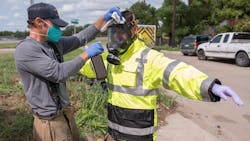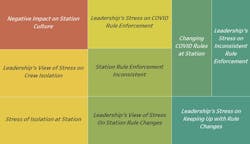COVID-Related Stressors' Impact on Fire Service Members
Editor's note: Find Firehouse.com's complete coverage of the COVID-19 pandemic here.
The fire service is facing significant challenges in recruitment and retainment efforts. As a result of lower fire academy numbers, decreasing funding sources, and challenging political climates, many departments are forced to increase mandatory overtime requirements on their members. Coupled with the already stressful nature of the job, these conditions are leading to higher burnout rates and turnover intentions.
When stressors are compounded – coming from both the operational (e.g., critical incidents) and managerial (e.g., mandatory overtime) aspects of the job – it can increase the risk of negative mental health outcomes. Firefighters may engage in maladaptive coping behaviors - alcohol consumption, withdrawal, insubordination, and outright refusal of orders – that lead to Post-Traumatic Stress Disorder (PTSD) and suicidal ideation. The fire service must address compounding stressors on their ranks and formulate plans to improve firefighter wellness.
Exposure to stressful events is synonymous with first responder careers. On the operational side, firefighters and EMS personnel arrive for each shift with the ready expectation to serve during a moment of crisis and deliver prompt and swift life-saving actions. As a result of this type of work, fire personnel are exposed to significant stressors such as catastrophic injuries, rendering aid to vulnerable populations, and death. Fire service leaders are no exception to these stresses, either. On the managerial side, fire administrators must balance overtime loads, hiring freezes, staff turnover, and internal communication challenges. Firefighters, in turn, may face issues with scheduling and staffing issues, leadership, or other crew members that also cause stress.
Stress and coping processes use up emotional resources. One may consider emotional resources like a gas tank: dealing with stress burns fuel from the tank and you must either refuel the tank (by coping with stress) or risk running the tank dry. Once the tank is dry, everything comes to a screeching halt. Unmanaged stress and empty tanks can lead to an increase in negative coping behaviors such as alcoholism, drug usage, and social withdrawal, which further deplete emotional resources. Hence, there remains a critical need to study components of firefighter stress and coping behavior. Our research team, made up of researchers from Oklahoma State University and the University of Texas at Dallas, are currently conducting studies with participating organizations to address these issues.
We feel our preliminary results are an important contribution to the fire service. COVID-19 is undoubtedly increasing the demands of fire service personnel to meet organizational and operational goals. But what impact is COVID playing on firefighter stress and subsequent coping behaviors? This question was one of the many research questions we explore in our studies.
During COVID, it was assumed that the increased exposures of potentially affected individuals would increase firefighter stress. However, that is not the case. Firefighter and EMS personnel have routine exposure to sick individuals. Adapting isolation protocols to meet the new threat is widely accepted, right? Not necessarily. The constant changes to Incident Action Plans (IAP) are a significant driver of fire personnel stress during COIVD, while the actual process of rendering care is causing minimal additional stress. In short, it is the managerial side of COVID, ever-changing protocols and procedures, rather than the operational side of COVID, that is most strongly affecting stress.
However, changing IAPs cannot be the only COVID-related stressor fire service personnel contend with, can it? No. There are many other types of stressors, including social isolation, failure to follow the rules, lack of enforcement, and negative station culture, which all contribute to increased stress levels. Based on our preliminary data gathered from fire departments, the heat map listed below shows the increased stress levels from left to right.
The number one COVID-related stressor impacting fire service personnel is the negative impact on station culture. Station culture is an essential component of a firefighter’s overall mental health. On average, one-third of a firefighter’s life is spent at the station. The station becomes a second home. But during COVID, station culture appears to increase firefighter stress. Of course, there are other studied dimensions, but for COVID specifically, social isolation, changing rules, and lack of enforcement are significant contributors to the overall station culture. Of the three dimensions mentioned, social isolation is the most significant contributor to poor station culture.
Firehouses are social places. Crews live within close quarters of one another. Meals are often shared over a large wooden table with friendly banter and storytelling. The crews have an intimate familiarization with one another, comparable to family members. During COVID, crews are experiencing isolation from one another, often through a department mandate. In some departments, crews are expected to remain isolated while still obligated to complete tasks. Based on our studies, social isolation is significantly correlated with work-family conflict and passive work withdrawal. Passive work withdrawal means avoiding work responsibilities, hiding out, looking busy when you are not, and performing the bare minimum needed to complete an assignment.
The second and third leading firefighter stressors during COVID go hand-in-hand with one another: rule enforcement and rule changes. Fire service personnel generally have a higher expectation of doing the right thing for others (altruism). So, failing to enforce rules seems like an outright attack to their foundational core. Therefore, inconsistent enforcement practices are the second leading COVID-related stressor to firefighters. Whereas fire service leadership places rule enforcement lower on the stressor factors, knowing that conflict exists anytime there is a difference between expectations and realities. Fire service leaders would be wise to increase enforcement practices to align firefighter’s expectations and realities. If left unchecked, this level of stress may lead to more active work withdrawal. Active work withdrawal is outright insubordination, vocal rejection of management, and other negative employment behavior.
Now, changing rules are difficult regardless of when they happen. People – generally – do not like change. COVID rule changes are no exception. Fire leadership acknowledges, and rightfully so, that rule changes are hardest on station personnel, but keeping up with the changes is difficult even for fire administrators. And the fire service leadership acknowledges that enforcement of rules is difficult and inconsistent. There may be a couple of factors driving these challenges.
First, the fire service organization is based on established practices. Many rules and procedures are created following a negative outcome, whether a near-miss, occupational injury, or line-of-duty death. However, COVID was not a planned event. As such, procedure and policy development occurred on the fly. Sure, science and technology were intricate factors in establishing these rules, but did your department take a top-down approach versus collaborative?
When new risks emerge, all organizations need to create collaboration and two-way communication opportunities. Consider adopting a team approach for policy and process making, including senior leaders, senior firefighters, and young-emerging firefighters. According to our studies, the constant rule changes increase the risks of burnout, turnover intentions, social withdrawal, both active-and-passive work withdrawal, and work-family conflict. Now is the time to take a more collaborative approach to rulemaking.
COVID is significantly impacting the operational tempo and focus within departments nationwide. Firefighters have a good pulse on how those changes are affecting them while leadership does not. One question we posed was whether the participant understood the effects of COVID on their crew. Firefighters are experiencing the impact of COVID on crew dynamics. Fire service personnel feel the effects of burnout, chronic fatigue, poor sleep patterns, and leadership shortcomings. Now is the time to investigate the impact of firefighter stressors in your department. Identifying these stressors may be able to help your department with appropriate resource allocations, request for budget increases, and potential grant opportunities.
Our research team is comprised of academics who specialize in organizational management, culture, and leadership. The findings of our study aim to improve the quality of firefighters' and fire administrators' lives. Our communities rely on the life-saving care the fire service provides, but even fire personnel need support.
Our research tools identify firefighter stressors that lead to poor performance, maladaptive coping behaviors, PTSD, suicide ideation, and ultimately burnout. The fire service faces many challenges as budget cuts continue to rise and fewer recruits enter the fire service ranks. If your department is interested in having a fire stressor research project, please reach out to the lead author at [email protected].
____
Steven Haynes is an Assistant Professor of Practice and Director of the Risk Management and Insurance Program at the University of Texas at Dallas. Steven is an experienced practitioner with over a decade of continuity and disaster risk management experience and served proudly in the United States Navy. He is also a Ph.D. candidate at Oklahoma State University, where his research interests include risk analysis, organizations under crisis, mixed methods research design, and disaster science. His research has been published in Safety Science and the Journal of Business Continuity and Emergency Planning.
David Huntsman is a PhD candidate in Fire and Emergency Management Administration in the College of Engineering, Architecture and Technology at Oklahoma State University. He recently accepted a Postdoctoral Research position at the University at Albany, where he will help lead numerous grant-funded projects and manage a research lab. David conducts interdisciplinary research on many topics, including emergency management, organizational behavior, and hazard adjustments using complex quantitative methodology. His most recent research has been published in outlets such as Safety Science and Risk, Hazards, and Crisis in Public Policy, and the International Fire Service Journal of Leadership and Management. David was also recently awarded the 2019-2020 Division of Engineering Technology Outstanding Graduate Student Award. He has worked with numerous fire departments around the country, exploring issues related to leadership, decision-making, and culture.
Dr. Lindsey M. Greco (Co-PI) is an assistant professor in the Management Department in the Spears School of Business. Her interests include stress and anxiety in the workplace, counterproductive work behavior, social identity at work, and research methods; her research currently appears in the Journal of Applied Psychology, Journal of Management, and The Leadership Quarterly among others.
Dr. Xiangyu (Dale) Li (PI) is an assistant professor of Fire and Emergency Management Program in the College of Engineering, Architecture and Technology. He received his PhD degree in Public Administration and Management from University of North Texas in 2014. Dr. Li has published 7 peer-reviewed articles in emergency management, local government management, and mental and behavioral impacts of disasters. He also published a book in risk management and decision-making for local governments in 2020.
About the Author
Steven Haynes
Steven Haynes is an Assistant Professor of Practice and Director of the Risk Management and Insurance Program at the University of Texas at Dallas. Steven is an experienced practitioner with over a decade of continuity and disaster risk management experience and served proudly in the United States Navy. He is also a Ph.D. candidate at Oklahoma State University, where his research interests include risk analysis, organizations under crisis, mixed methods research design, and disaster science. His research has been published in Safety Science and the Journal of Business Continuity and Emergency Planning.

